Map Google Drive as a Network Drive
Google Drive provides a backup and sync client for Mac and Windows that lets you sync the contents of your Drive to your desktop. But ExpanDrive is a special kind of Google Drive client that lets you map Google Drive as a drive letter on Windows 7 through Windows 11 and on macOS. It connects directly to Google via their API and provides you with a virtual shared drive.
ExpanDrive lets you turn Google Drive into an actual shared drive. This has a number of advantages. First, you don’t have to sync the entire library of content to actually use it. If your laptop only has 128GB of storage, it’s pretty hard to make good use of a 10TB Google Drive account.
First Download ExpanDrive for Mac or Windows and install it. ExpanDrive sits in the system tray near your clock – just like the Google Drive client. Next, add a new Google Drive to ExpanDrive, click connect – and you’re done. You can now access Google Drive as a virtual drive from within any application on your Mac or PC. For more detailed instructions, check out our documentation on how to Map Google Drive as a drive using ExpanDrive.
OneDrive and Sharepoint on Linux in 2023
OneDrive, SharePoint, and Linux on the Desktop are more popular than ever. Despite that, Microsoft provides no first-party client to connect to their cloud storage on Linux. They probably never will. And that’s okay.
Thankfully, there are options. They fall into two main categories:
- Sync-style apps, where all of your remote content is first synced down and cached locally in a hot folder on your machine and uploaded when changes are made.
- Drive-based apps, where the remote storage shows up like an external or network drive, and the content is accessed on demand.
Sync-style options
There are a few quality open-source options that provide a sync-style client, such as abraunegg’s command-line OneDrive client. This option can be pretty intimidating, depending on your level of comfort. You’ll need to drop into the command line and config files to get a consistent setup and read through some dense docs on the various options available.
Certainly not a bad option, and probably the go-to open-source option out there. But it's not for everyone. It also is a sync client, meaning you’ll be syncing down a lot of extra data you might not need.
While sync is nice, in that it merely looks like a local folder, if you have a lot of data or data you rarely use, it can take up a lot of wasted space.
Connecting as a network drive is the natural solution to this. You can access your entire library of remote files, edit them, upload, and manage them—but you don’t need to spend time or free space by pre-downloading them.
Mounted drive options
ExpanDrive is a powerful OneDrive for Linux client that supports Ubuntu, Linux Mint, CentOS, Fedora, Redhat, and most popular distributions. It supports two-way sync via a mounted drive to OneDrive, OneDrive for Business, and SharePoint by securely connecting to the Microsoft Graph API.
Unlike other clients, ExpanDrive doesn’t pre-sync your data to a hot folder, taking up time, disk space, and bandwidth downloading data you don’t need. It accesses OneDrive, OneDrive for Business, and SharePoint on demand by only downloading the data you or your app request.
Released April 10th, 2023
ExpanDrive runs on Ubuntu, Red Hat, Linux Mint, CentOS, Debian, and most other popular distributions. We provide Deb and RPM-based installers and have an integrated auto-updater to help you stay up to date. ExpanDrive connects to OneDrive, SharePoint, and OneDrive for Business as a fast network drive.

Installing ExpanDrive
Released April 10th, 2023
Desktop-based installations
ExpanDrive ships primarily as a desktop app with a user interface for advanced configuration and management. We also have a server edition that runs headless for Windows and Linux Servers.
Debian and Ubuntu-based desktop distributions
For Debian and Ubuntu-based distributions, the easiest way to get started is to download and install the latest .deb package (64-bit), either through the graphical installer or via the command line with the following command:
sudo apt install ./ExpanDrive_2023.4.1_amd64.debInstalling the .deb will also automatically install the apt repository and code signing key to enable easy updates using the system package manager.
You can install the repository and key manually with the following script:
curl https://packages.expandrive.com/keys/expandrive.asc | gpg --dearmor > packages.expandrive.gpg sudo install -o root -g root -m 644 packages.expandrive.gpg /usr/share/keyrings/ sudo sh -c 'echo "deb [arch=amd64 signed-by=/usr/share/keyrings/packages.expandrive.gpg] https://packages.expandrive.com/expandrive stable main" > /etc/apt/sources.list.d/expandrive.list'Then update the package cache and install ExpanDrive using:
sudo apt-get install apt-transport-https sudo apt-get update sudo apt-get install expandriveRHEL, Fedora, and CentOS-based desktop distributions
Download our latest .rpm package (64-bit) and use yum to install ExpanDrive and the required dependencies:
sudo yum localinstall ./ExpanDrive-2023.4.1.x86_64.rpmInstalling the .rpm will also automatically configure the yum repository and code signing key to enable easy updates using the system package manager.
You can install the yum repo manually using the following script:
sudo rpm --import https://packages.expandrive.com/keys/expandrive.asc sudo sh -c 'echo -e "[expandrive]\nname=expandrive\nbaseurl=https://packages.expandrive.com/rpm\nenabled=1\ngpgcheck=1\ngpgkey=https://packages.expandrive.com/keys/expandrive.asc" > /etc/yum.repos.d/expandrive.repo'Then update your package cache and install ExpanDrive using dnf (Fedora 22 and above):
sudo dnf check-update sudo dnf install expandriveOr using yum:
yum check-update sudo yum install expandriveServer/Headless Edition
Head over to our ExpanDrive Server Edition page for instructions and packages for Windows and Linux servers. ExpanDrive Server Edition is designed to run unattended, at boot (versus login), and provides drives that can even be re-shared on the network.
We are currently in public beta testing for this server edition designed to run without any user interaction. If you’re interested in joining the beta, please send an email to support@expandrive.com letting us know which distro you’re running and what your rough use-case is.
Mount OneDrive or SharePoint as a Drive on Linux
ExpanDrive is a OneDrive client that lets you connect your files using a fast network drive. Like Microsoft’s built-in client on Windows 11, everything is accessed on demand. You can browse and open any file from within your file manager or from the command line. ExpanDrive builds native access to OneDrive into Linux.
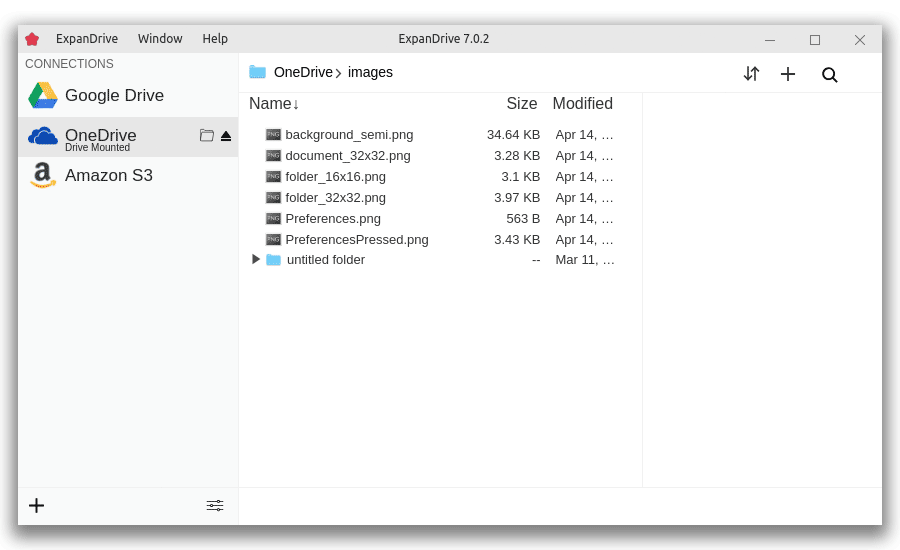
Amazing Reviews

“ExpanDrive lets you mount remote SFTP drives and it actually works! I.e. no long delays or dropped connections in the middle of a save.”
Allan Odgaard, TextMate

“My first impression after reading ExpanDrive’s promotional description last week was that it sounded too good to be true. One week later, I’m pretty sure it actually is that good.”
John Gruber, Daring Fireball
Hello, Linux
ExpanDrive is currently shipping for Linux Desktop environments as well as a headless server edition.

- Ubuntu
- Linux Mint
- Fedora
- CentOS
- RedHat
- Arch Linux
- OpenSUSE
- Debian
OneDrive Network Drive
ExpanDrive for Linux has a full-featured file explorer as well as a fast network drive client. This builds support for OneDrive into every application in your environment, including terminal apps and the file explorer.
S3 Browser for Mac, Linux and Windows
Amazon S3 Browser for Mac, Linux and Windows
ExpanDrive is a fast and powerful Amazon S3 client that lets you browse S3 (or S3-compatible) storage. It builds native access to S3 directly into Finder and your Mac system at the filesystem level. Finder and Explorer, or any other application, can browse your S3 buckets natively and access the remote content on-demand. It effectively turns your Mac, Windows, or Linux machine into an S3 Browser. This lets you browse S3 storage without needing to sync down any of the data in advance. You can view buckets, manage files, and transfer large amounts of data from within any application.
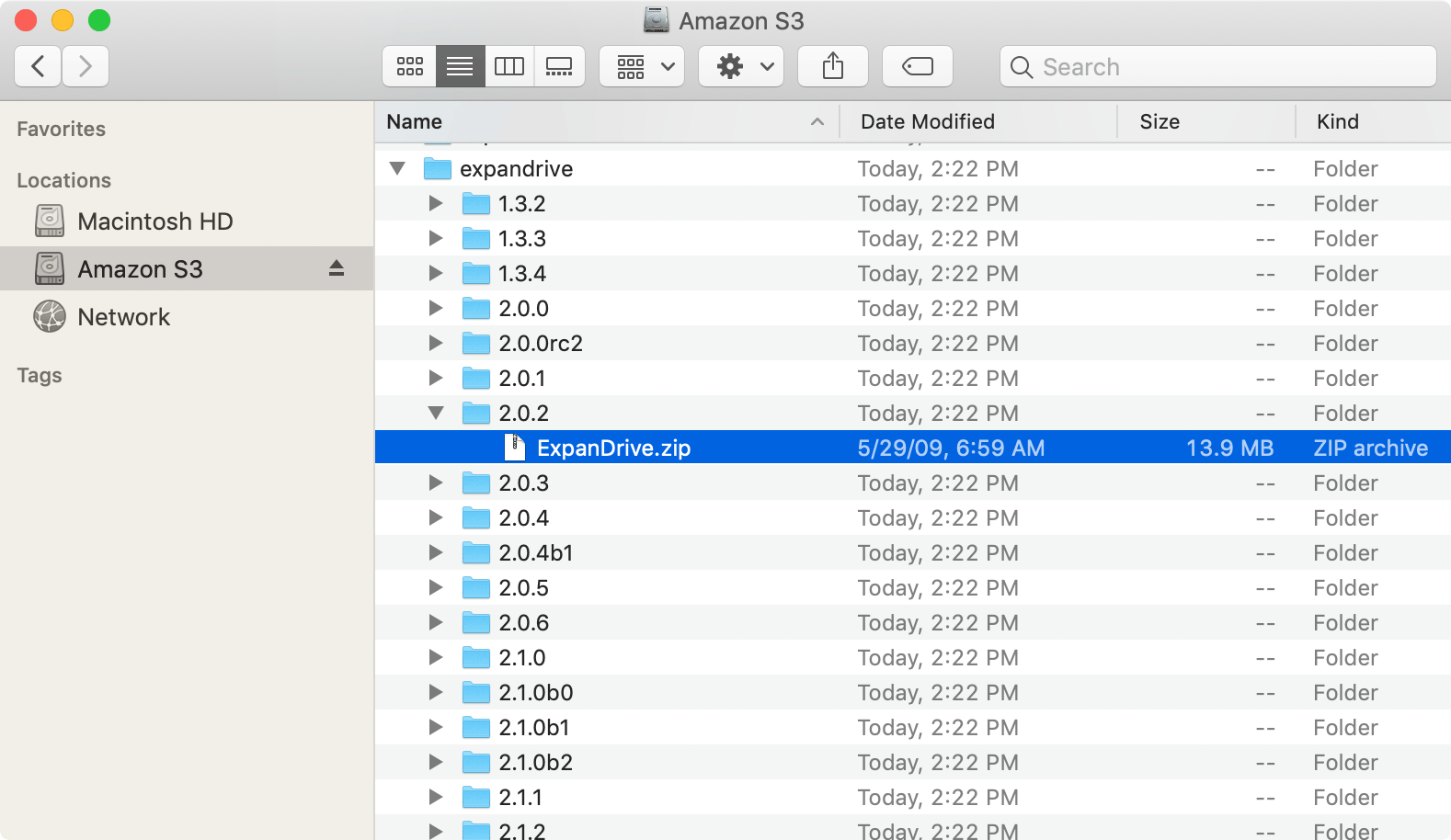
In addition to filesystem integration, ExpanDrive 7 has a powerful cloud storage browser and file manager. It surfaces more advanced features of S3 like setting the ACL for a given object or modifying its storage class.

If you’re looking for a simple S3 uploader, ExpanDrive’s storage browser has a blazing fast uploader built in that is designed for bulk upload and data migration. Files are uploaded in the background with our multi-threaded transfer engine. This makes uploads feel instant and doesn’t leave you waiting on transfers while you continue to go about your work.
Download ExpanDrive
Version 2023.4.1 for Mac, Windows and Linux
April 10th, 2023
S3 Browser Options for Mac
Most consumer-focused cloud storage services like Dropbox or Google Drive come with their own desktop sync client. S3 is different in this respect. It is a developer/infrastructure-focused service that is primarily accessed by an API that requires a third-party client to access. Amazon provides a fairly basic web interface, but other than that, the only way to get data in and out of it is via the API.
There are a wide variety of clients to access S3, like S3 Browser or Transmit for the Mac. DragonDisk used to target this use case but development ceased a few years ago. Most of these provide basic access to S3, but don’t offer native access to content. ExpanDrive provides advanced functionality and turns S3 into an infinite-capacity external drive.
Bucket Level Organization
To get started, load ExpanDrive and input your access key ID and secret key. Connecting mounts the root of your AWS account. Now you can use Finder or Explorer to browse your buckets and drill into them.
S3 is organized into buckets, which are top-level folders uniquely named throughout the service. You can attach various policies to a bucket such as restricting access to particular users or making hosted content available to the public. ExpanDrive lets you mount the root of your S3 account, showing you all your buckets (if your user has permission to list buckets). You can restrict the mount to a specific bucket or even a particular folder in a bucket by typing the bucket name in the remote path section. For additional details, check out our documentation on connecting to S3. This is useful if you have an IAM user with access to only a single bucket or don’t have permissions to list the buckets for an account.
Powerful Server Edition
Head over to our ExpanDrive Server Edition page for instructions and packages for Windows and Linux servers. ExpanDrive Server Edition is designed to run unattended at boot (versus login) and provides drives that can even be re-shared on the network.
Browse S3-Compatible Storage like Wasabi
Amazon provides a simple guide to get started with their S3 service. ExpanDrive is also compatible with any S3-protocol compatible service like Wasabi or Dream Objects. For Wasabi, ExpanDrive has a built-in connection profile. But you can also select the Amazon S3 connection profile and modify the server field to connect to storage services like Dream Objects, Ceph, Cleversafe, Oracle, and more.
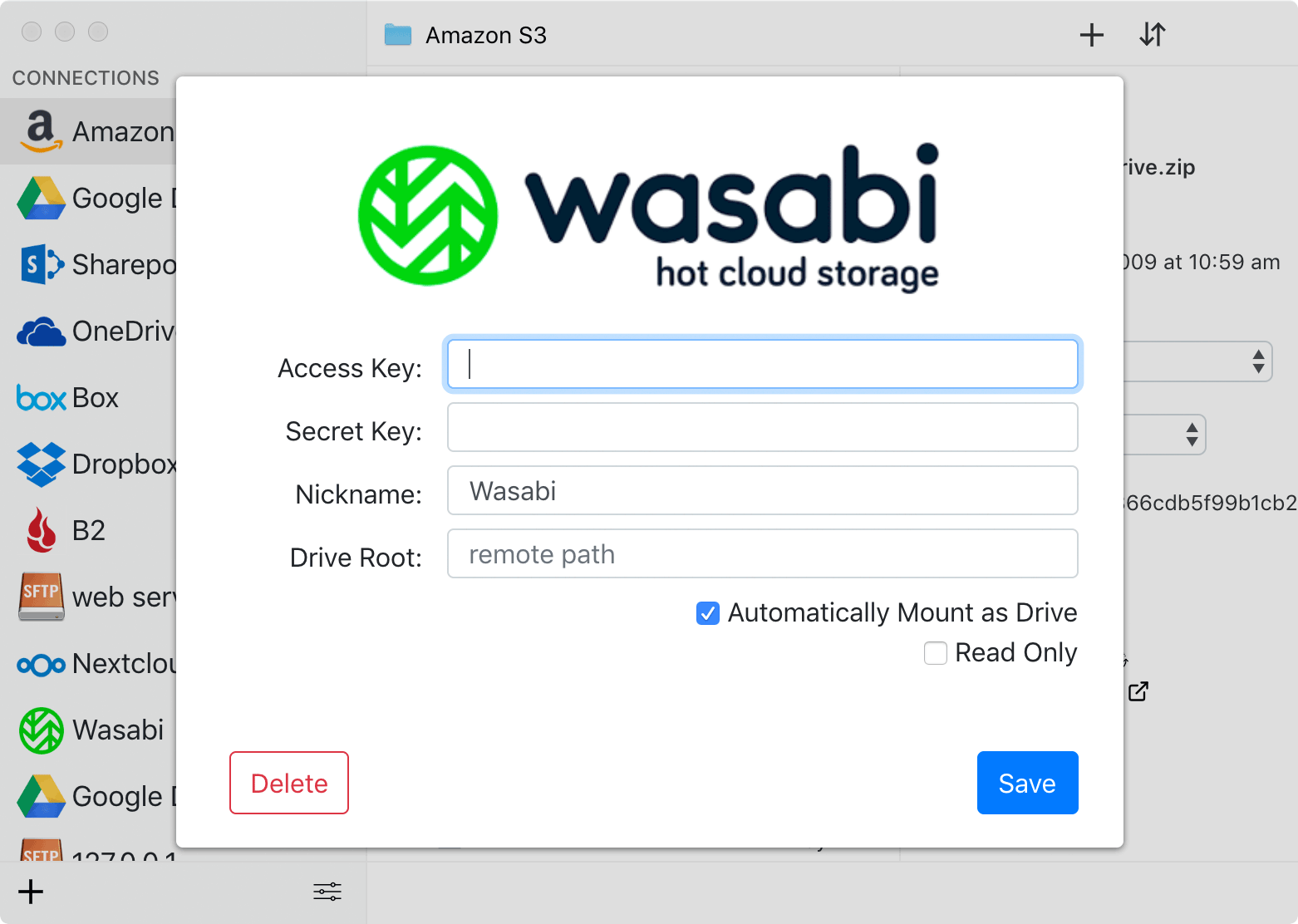
Click Save or Connect and you’re good to go. Amazon S3 will now be visible as a network drive whenever you log in to your computer, letting you access all of your content from Finder, Explorer, Photoshop, Microsoft Office—whatever!
Drag and drop files to copy them out to the cloud. You can even stream media content like movies and music directly from the S3 storage without needing to download or sync them first. For more information, check our documentation page on connecting ExpanDrive to S3.
System Requirements
ExpanDrive supports macOS 10.12 or newer and a wide variety of Linux distributions, including Ubuntu, Linux Mint, Centos, Fedora, Redhat, and more. Learn more about how to install ExpanDrive for Linux here.
ExpanDrive runs on Microsoft Windows 7 through Windows 10. Windows Server 2012+ is also supported, as well as RDP/Terminal services environments. ExpanDrive can isolate multiple users logged into the same machine so they each have their own view of cloud storage.
Using Sharepoint on Mac in 2023
Sharepoint keeps gaining in popularity and while Microsoft does let you connect to document libraries from the OneDrive client, it leaves quite a bit to be desired. There isn’t a great way to specify the document libraries you want, and the reliability of OneDrive app can be pretty poor.
Sharepoint via the Web
Most users get to Sharepoint via the web. It has all features that Sharepoint offers, is managed by Microsoft, and is relatively easy to use. The biggest downside to this method is that there is no native integration with any of your existing workflow and applications you use to manage and generate content. In order to get the richest experience via the web you’ll want to make sure you have a modern version of your browser. Microsoft keeps this list of supported browsers.
Mapping a Drive via WebDAV
While mounting Sharepoint as a network drive you can use WebDAV in certain situations in a Windows environment, it doesn’t function correctly on Mac when connecting to Office 365. It doesn’t support modern authentication constraints like 2 factor auth or any login federation. Additionally, it only provides a simple read/write interface and none of advanced sharing functionality.
Microsoft Document Connection
In versions of Office previous to 2016 Microsoft included an app called Document Connection to move data in and out of Sharepoint, but it has been since discontinued in favor of more direct integration inside the office 365 apps.
Mapping a Network Drive
Third-party tools like ExpanDrive integrate directly with the Sharepoint API building in native access to any Mac. A user authenticates one time using the same login flow a they access Office 365 via the web, including MFA and SAML configurations. They can then access their entire Sharepoint setup as a fast, aggressively cached network drive that provides advanced features like smart-sync offline mode, integrated link sharing, and more.
OneDrive sync client
Another option is to use the OneDrive sync client to access Sharepoint on your mac. It provides reasonable integration and speed and is available from Microsoft. However, it doesn’t make managing a configuration with fine grained permissions and many different sites particularly easy.
ExpanDrive 7 – The Best Gets Even Better
It’s finally here! ExpanDrive 7 brings massive performance improvements and a huge array of new features and improvements to all aspects of the app. It also now runs on Linux!
Download ExpanDrive
Version 2023.4.1 for Mac, Windows, and Linux
April 10th, 2023
ExpanDrive 7 now includes an incredibly powerful cloud storage browser and transfer app along with the best network drive for the cloud. Take a look:
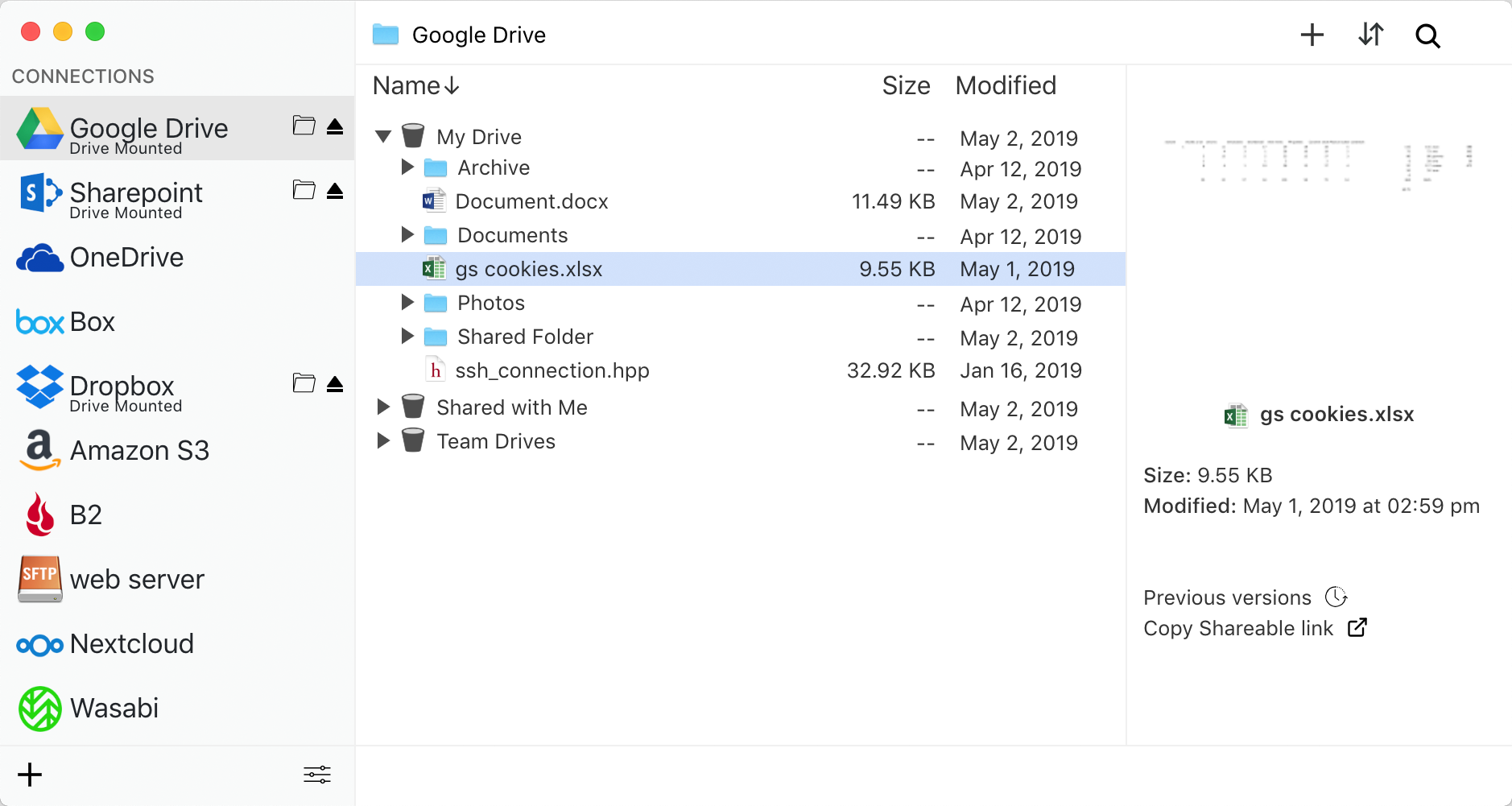
ExpanDrive’s storage browser features advanced controls for file transfer, version management, and server-side search.
Dramatically faster and more powerful
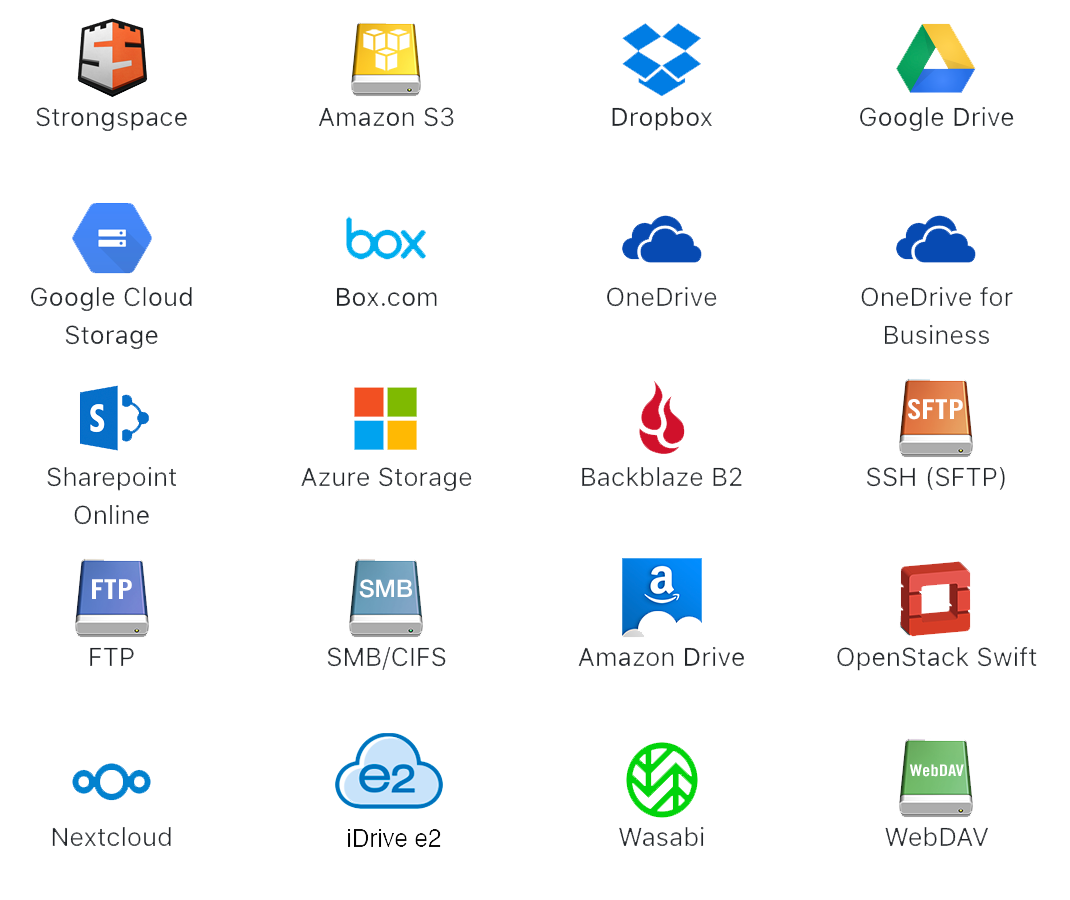
Connect to all major cloud storage providers, or your own server. With a single app, you can connect to:
- Dropbox
- Google Drive & Team Drives
- Box
- OneDrive
- SharePoint
- Nextcloud

- Microsoft Azure Storage

- Wasabi

- Amazon S3
- Backblaze B2
- SFTP/FTP, WebDAV
Hello, Linux 

Major storage providers have left you behind and we’re here to help. ExpanDrive adds native cloud storage access into Linux for all major Linux distributions, including Ubuntu, Mint, CentOS, RedHat, and more.
Improved Smart Offline Sync 

Choose files for offline access and work without an internet connection. Synchronization to the cloud takes place automatically when you’re back online. Other files are accessed on-demand from the cloud, taking no disk space.
Integrated Search 

ExpanDrive hooks into Spotlight Search on Mac and Windows file search. Quickly search your remote storage for whatever you’re looking for. The integrated storage browser has additional support for blazing-fast server-side search.
Multi-user file locking 
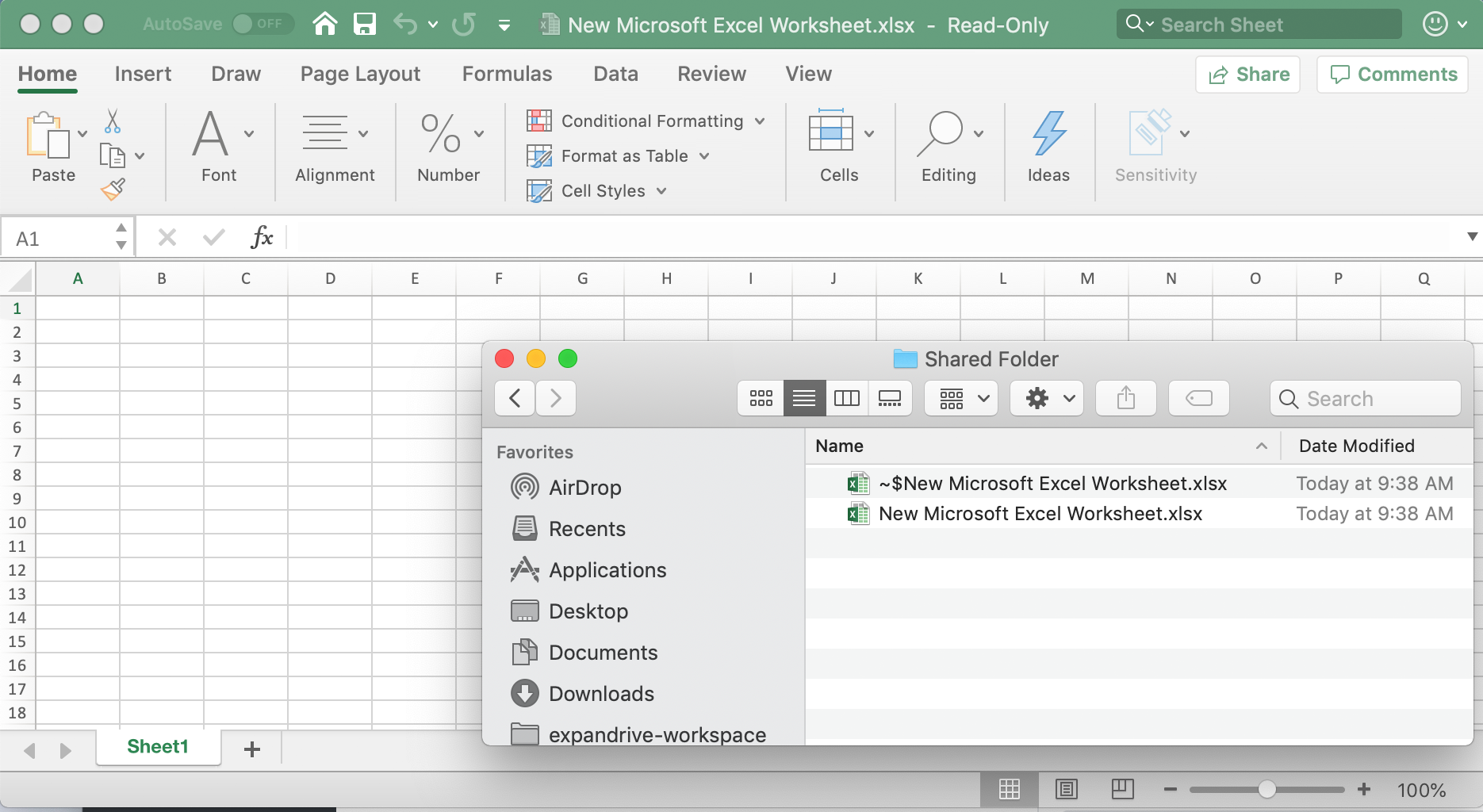
ExpanDrive now propagates lock files in Microsoft Office documents across the cloud. If a user is editing an Office document, other users will only be able to open that document read-only until the editing user closes it.
File Version Management 
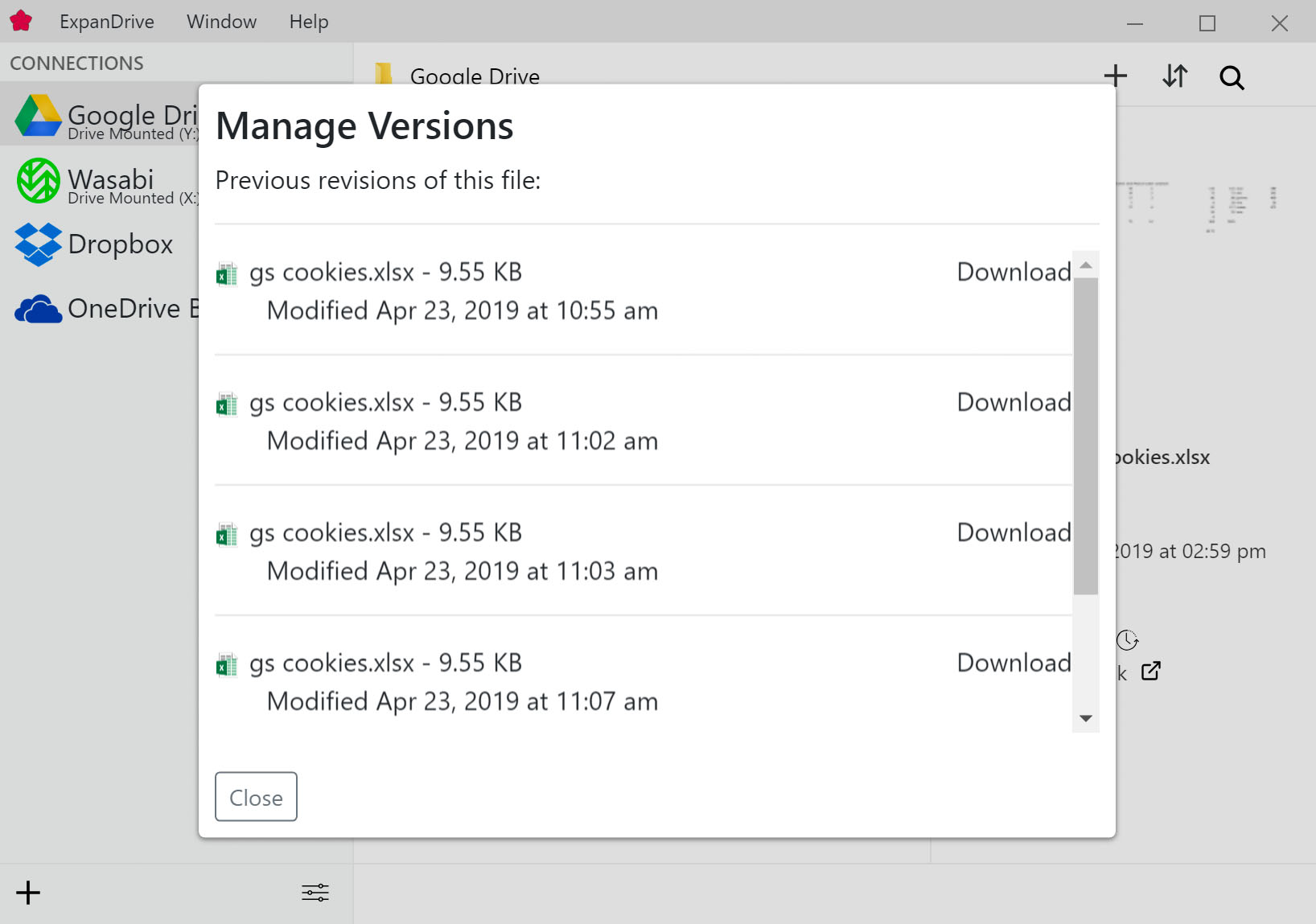
Easily access older versions of files on cloud storage backends that support versioning, including Box, Dropbox, S3, Google Drive, OneDrive, and SharePoint.
Download ExpanDrive
Version 2023.4.1 for Mac, Windows, and Linux
April 10th, 2023
ExpanDrive supports macOS 10.12 or newer and a wide variety of Linux distributions including Ubuntu, Linux Mint, CentOS, Fedora, RedHat, and more. Learn more about how to install ExpanDrive for Linux here.
ExpanDrive runs on Microsoft Windows 7 through Windows 10. Windows Server 2012+ is also supported, as well as RDP/Terminal services environments. ExpanDrive can isolate multiple users logged into the same machine so they each have their own view of cloud storage.
Map Sharepoint Drive on Mac, Windows and Linux (2023)
ExpanDrive is a Sharepoint client that lets users securely map a drive to their Microsoft 365 account. It integrates directly with your operating system, providing filesystem-level access to all remote files. This means you can browse, upload or edit Sharepoint directly from within Finder, Explorer, or any application on your machine. Simply put – Sharepoint shows up just like a shared drive. ExpanDrive runs on Mac, Windows and Linux – including Ubuntu, Linux Mint, Centos, Redhat, and more.
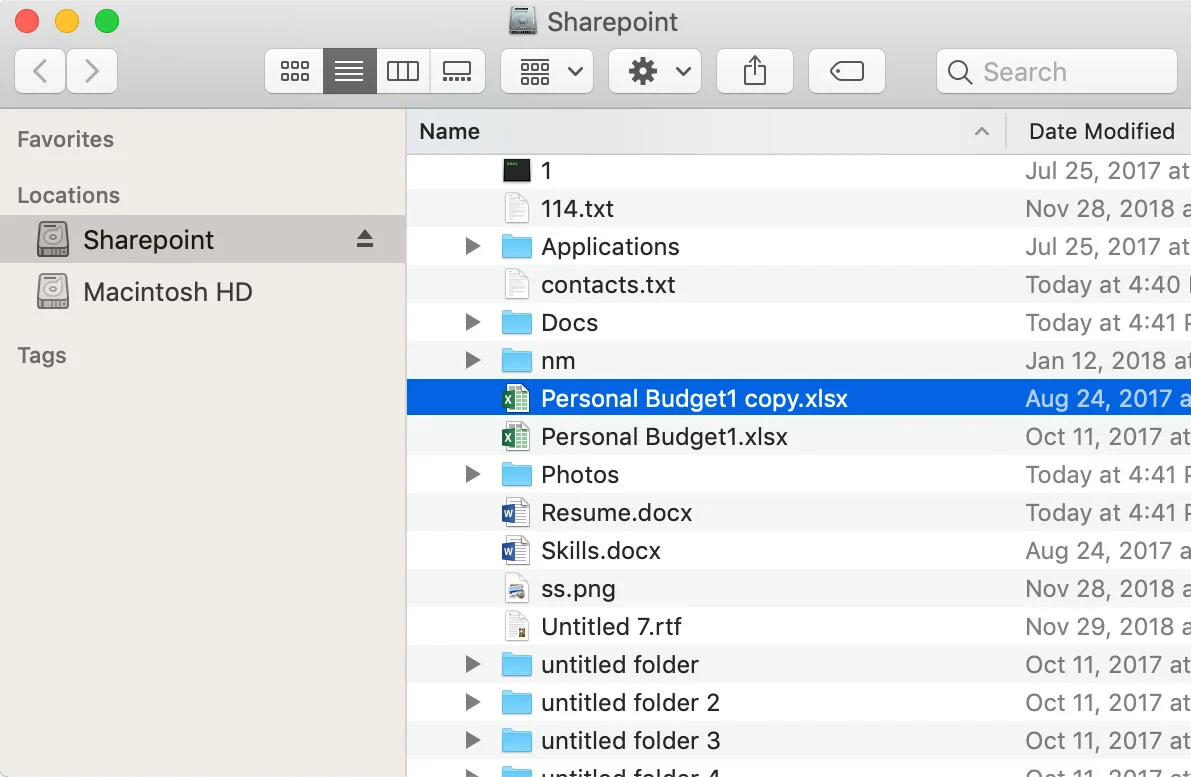
ExpanDrive accomplishes this mapping by securely connecting to Microsoft’s Graph API and translating the API into a filesystem for Mac, Windows and Linux. Authorization is fully handled by Microsoft. It fully integrates with your SSO setup and multi-factor authentication setups like Okta, Duo and Auth0 work seamlessly.
Download ExpanDrive
Version 2023.4.1 for Mac, Windows and Linux
April 10th, 2023
Sharepoint client for Mac and Windows and Linux
Microsoft provides a Sharepoint sync client for the Mac as well as for Windows. Native access to your files in the cloud is critical for any serious workflow. However, if you don’t want to eat up tons of disk space and bandwidth syncing files you rarely use it makes sense to map Sharepoint as a network drive.
What good is unlimited storage your only supported mechanism move data is via sync. Using a sync client you generally have a folder on your machine that has a copy of all of your files pre-downloaded and it watches for chances. Unless your laptop has a 10TB hard drive you can’t fully sync your account. With drive based you access only what you need, when you need it.
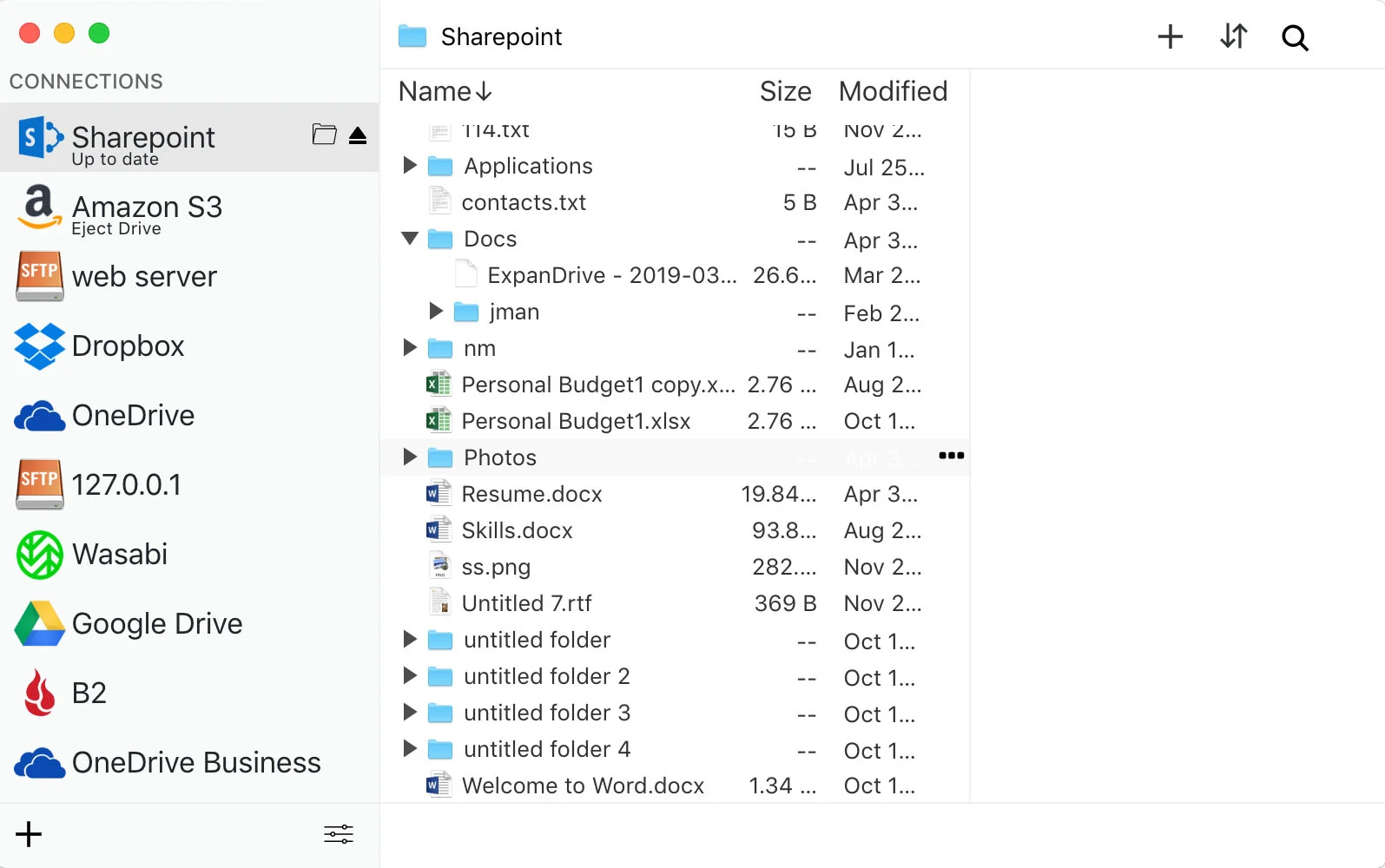
ExpanDrive also is a full featured Sharepoint browser and uploader manager, to help you with data migration and management. It keeps you connected and your files accessible without needing to log into a browser.
Files on Demand in Finder and Explorer
When you double click a file from Finder or Explorer it is transparently downloaded in the background. The same goes for any app on your machine, like Word, Excel, Photoshop – whatever. It builds Sharepoint support right into the operating system.
ExpanDrive access files on demand, not taking up valuable hard drive space by pre-syncing your entire site or document library.
Map individual subsite or document library
Another nice feature of a Sharepoint client that connects via a mounted drive is that you can do things like map a specific Sharepoint subsite. This lets you turn a single document library that might be deeply nested into its own drive letter within Explorer or mounted volume in Finder.
To get this going with ExpanDrive you first create a connect connection to Sharepoint, and after you have completed the authentication you want to modify the server field before you connect and save the drive so it matches the site you’re trying to map.
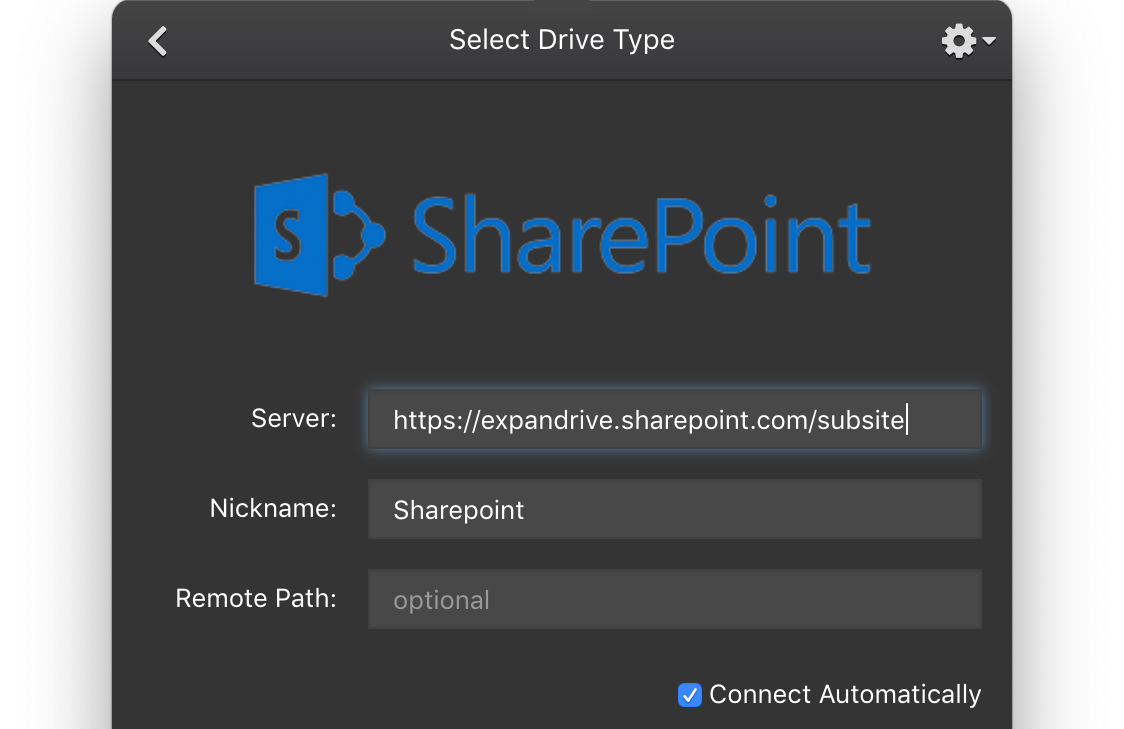
In this case I am mounting the site named “subsite” on our Office 365 account. This should usually be a simple sitename, or is sometimes “/sites/subsite.” Check what the site URL via your web browser if you’re unsure.
After you’ve hit the connect button can see that subsite Document library directly within Finder. If you want to map directly into the Document library, you can sent “/Documents” under the remote path setting.
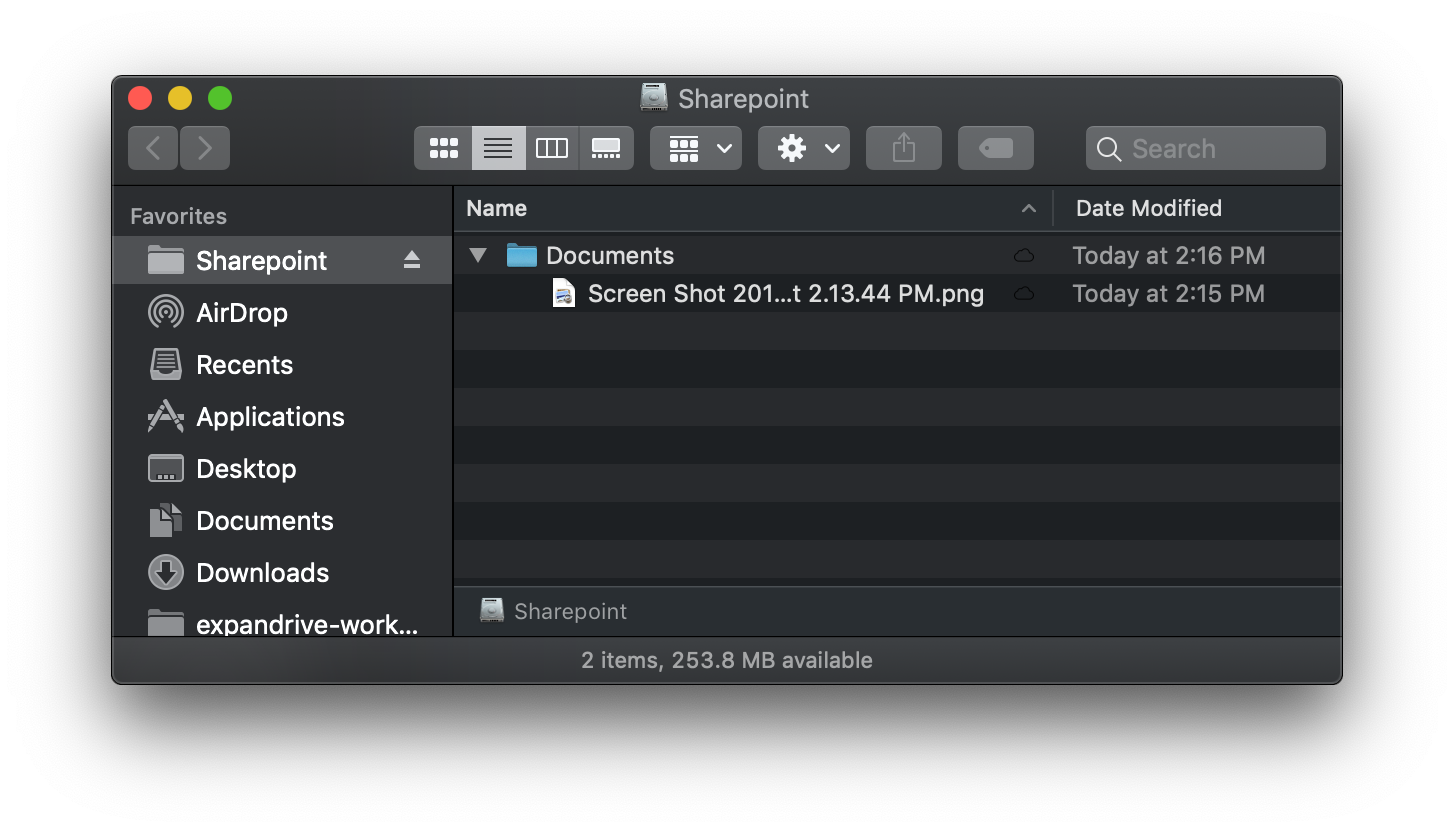
Sharepoint access within Finder and Explorer
ExpanDrive lets you map your Sharepoint account as drive letter on Mac or Windows. You can browse and access your account without needing to first sync your files, which takes up time and space on your laptop. Just access what you need, when you need it, from within any app like Finder, Windows Explorer, Microsoft Word, Photoshop, or whatever you use. Everything is safely in the cloud but not taking up space on your computer. Isn’t that the point of cloud storage anyways?
System requirements
ExpanDrive supports macOS 10.12 or newer and a wide variety of Linux distributions including Ubuntu, Linux Mint, Centos, Fedora, Redhat, and more. Learn more about how to install ExpanDrive for Linux here.
ExpanDrive runs on Microsoft Windows 7 through Windows 10. Windows Server 2012+ is also supported as well as RDP/Terminal services environments. ExpanDrive can isolate multiple users logged into the same machine so they each have their own view of cloud storage.
Multiple Google Drive accounts on macOS and Windows (2023)
ExpanDrive is a powerful client that lets you connect 2 or even multiple Google Drive accounts at the same time on macOS and Windows and Linux. Google's Backup and Sync client and File Stream client are only able to connect to a single Google WorkSpace account.
Download ExpanDrive
Version 2023.4.1 for Mac, Windows and Linux
April 10th, 2023
Connect Two Google Drive Accounts at once
Many users have a Google Workspace account for work or school as well as a personal one. With multiple accounts your only option to move data in and out of both of those is using the browser. This might be fine for occasional use, but any serious user relies on native access to their files. Also, using a sync-style client has the additional issue of eating up valuable hard drive space storing files you might not need, or need infrequently.

Map a specific Team Drive
In addition to connecting multiple drives, ExpanDrive lets you connect to specific team drives alongside your primary account. This is handy for users who only do work inside a certain team drive and don’t need visibility into the rest of the organization’s data hierarchy.
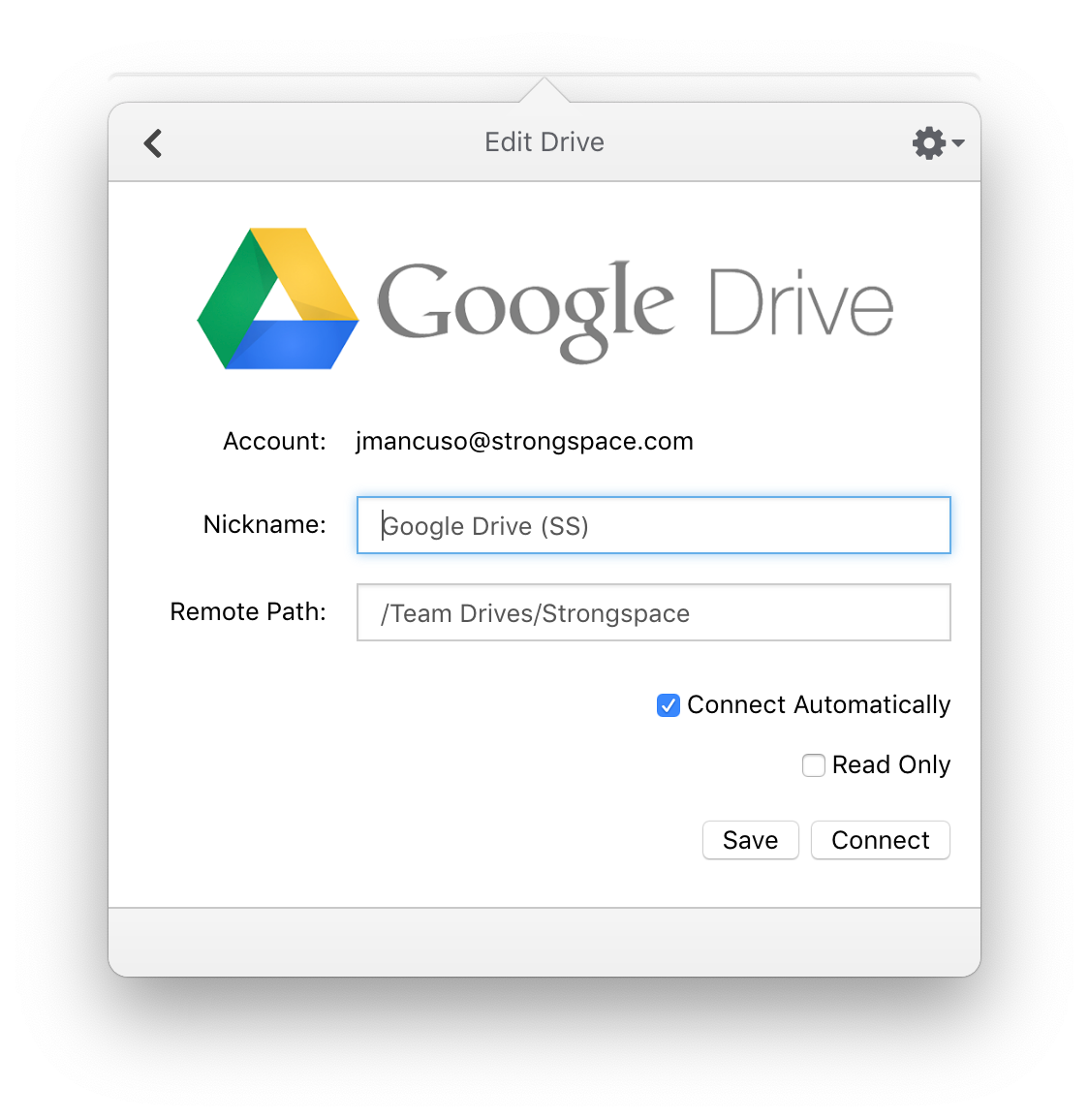
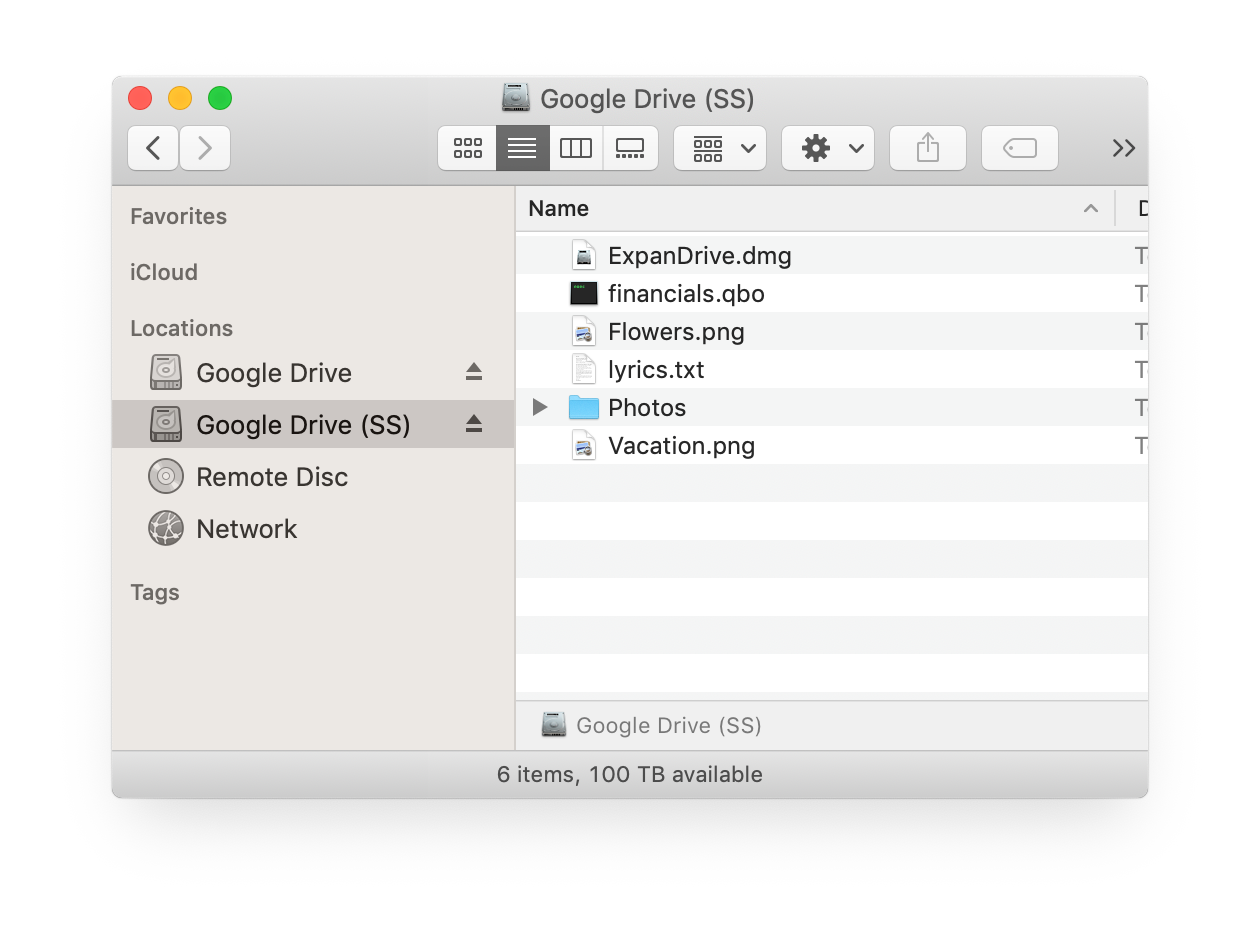
Access multiple Google Drive Accounts on demand without sync
ExpanDrive is a special kind of Google Drive client that lets you access multiple Google Drive accounts as a fast network drive. You can even mount a specific Team Site or a subfolder within your account. ExpanDrive securely connects via the Google API. You can connect as many accounts on one machine as you want. All of the files are accessed without needing to sync down the content.
Learn how to connect to multiple google drive accounts
It’s easy as authenticating multiple accounts and assigning them unique nicknames, give it a try for free.
System Requirements
ExpanDrive supports macOS 10.12 or newer and a wide variety of Linux distributions including Ubuntu, Linux Mint, Centos, Fedora, Redhat, and more. Learn more about how to install ExpanDrive for Linux here.
ExpanDrive runs on Microsoft Windows 7 through Windows 10. Windows Server 2012+ is also supported as well as RDP/Terminal services environments. ExpanDrive can isolate multiple users logged into the same machine so they each have their own view of cloud storage.
"Map Amazon S3 Drive on macOS or Windows (2023)
Map S3 as a Network Drive with ExpanDrive
If you’re looking to connect to S3 as a drive, ExpanDrive is an amazing option. ExpanDrive is a S3 client for Mac and Windows that lets you connect to S3 as a fast network drive. It has been under active development for more than 10 years and is one of the fastest and most reliable S3 clients available. All your files in the cloud are available from within any application including Finder and Explorer.
Download ExpanDrive
Version 2023.4.1 for Mac, Windows and Linux
April 10th, 2023
Amazon S3 is Amazon's API-driven, amazingly durable cloud storage service. Launched over fifteen years ago, in 2006, it was the first offering of what is now Amazon Web Services.
S3 desktop client options
Most consumer-focused cloud storage services like Dropbox or Google Drive come with their own desktop sync client. S3 differs in that it is primarily driven by an API which you need a client like ExpanDrive in order to take advantage of on your desktop. Amazon provides a fairly basic web interface, but other than that the only way to get data in and out of it is via the API.
There are a wide variety of clients to access S3, like S3 Browser or Transmit for the Mac. ExpanDrive is unique in that it translates the S3 API into an infinite-capacity external drive for macOS or PC. In practice this means Finder and Explorer now have S3 built in, as does every other app on your machine. ExpanDrive also operates as a great general S3 Browser for Mac and Windows.
Bucket level organization
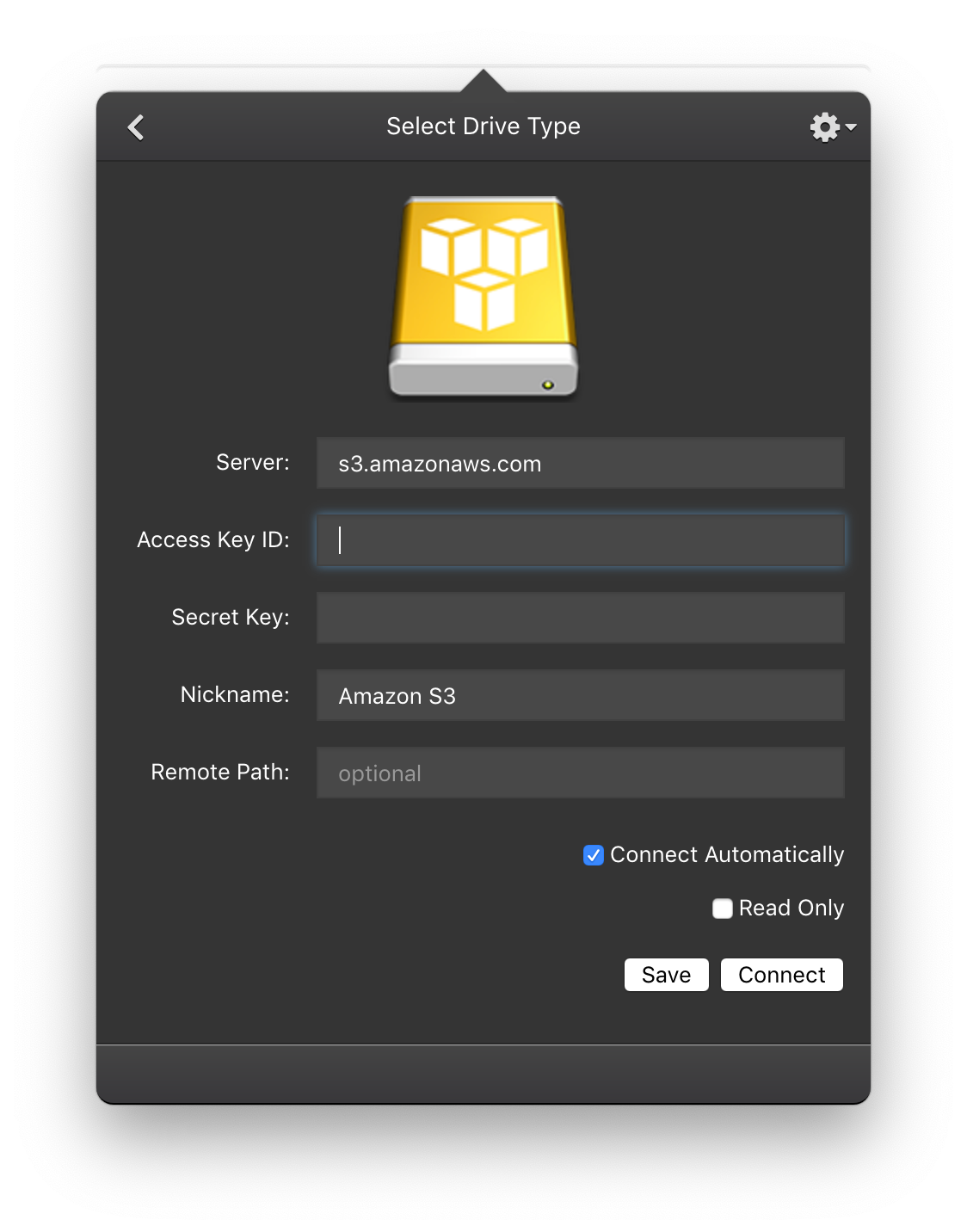
S3 is organized into buckets, which are top-level folders that are uniquely named throughout the service. You can attach various policies to a bucket such as restricting access to particular users or making hosted content available to the public. ExpanDrive lets you mount the root of your S3 account, showing you all your buckets (if your user has permission to list buckets). You can restrict mount a specific bucket, or even a particular folder in a bucket, by typing the bucket name in the remote path section. For additional details you can check out our documentation on connecting to S3
S3FS for Mac and Windows
Tools like S3FS for linux perform a similar function but lack critical features like background writes, smart synchronization of files for offline access and multi-threaded reads and writes. With ExpanDrive you get a host of extra features and robust performance. Users can access petabytes of data from their laptop as if it was local. ExpanDrive works as a free S3 Client for macOS and Windows that connects you to Amazon S3 as a fast network drive.
Creating a virtual drive with Amazon S3
Amazon provides a simple guide to get started with their S3 service. You’ll need an AWS account, as well as a bucket. From there, you’ll want to get your API keys to authenticate with ExpanDrive. Haystack Software has a nice guide on how to get the keys. As with any AWS keys, it is recommended to use IAM keys rather than your root keys.
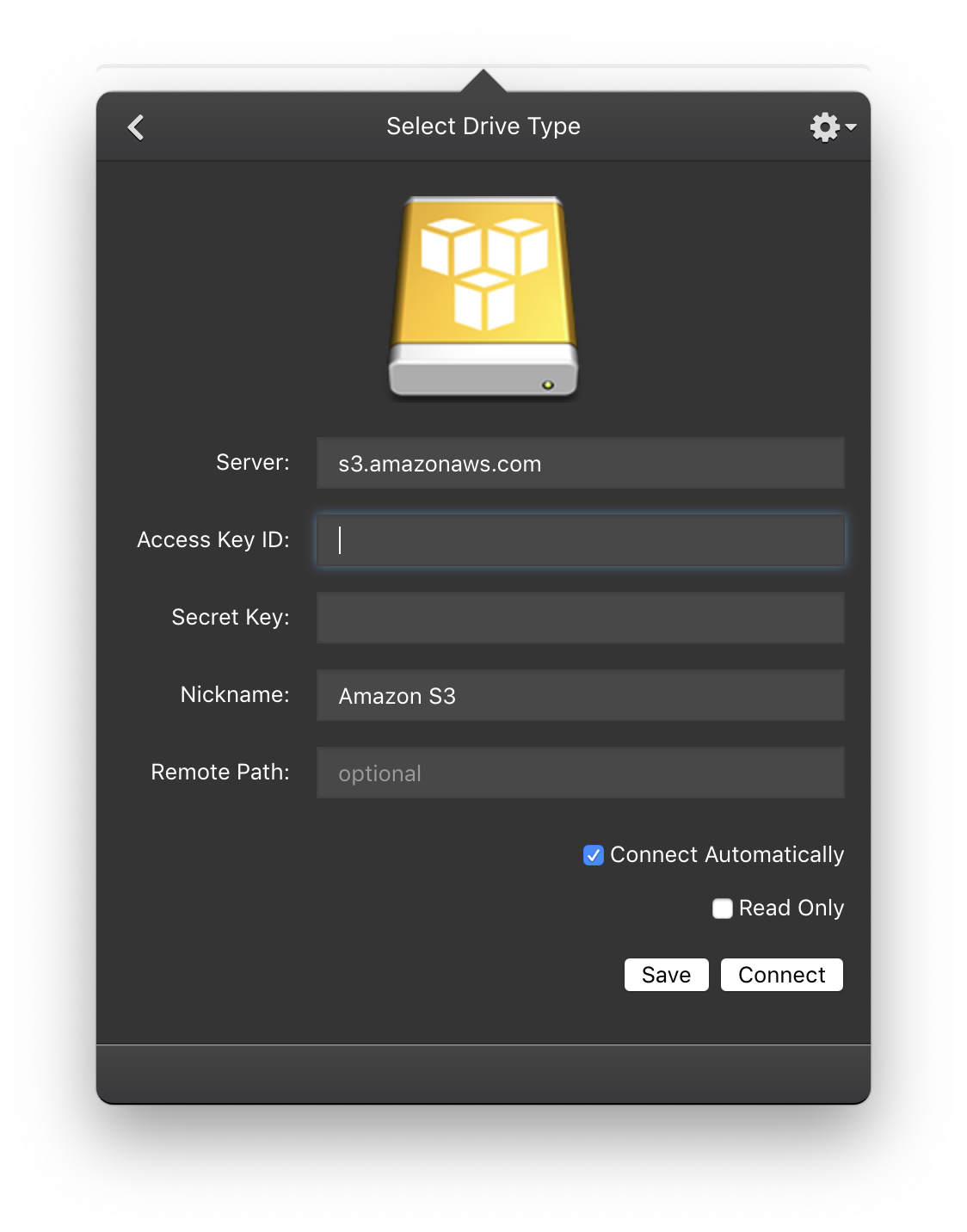
Add your Access key and Secret Key, then click Save or Connect and you’re good to go. Amazon S3 will now be visible as a network drive whenever you login to your computer – letting you access all of S3 from Finder, Explorer, Photoshop, Microsoft Office – whatever!
Drag and drop files to copy them out to the cloud. Or stream movies and media directly from S3 without needing to first download or sync them. For more information, check our documentation page on connecting ExpanDrive to S3.
System Requirements
ExpanDrive supports macOS 10.12 or newer and a wide variety of Linux distributions including Ubuntu, Linux Mint, Centos, Fedora, Redhat, and more. Learn more about how to install ExpanDrive for Linux here.
ExpanDrive runs on Microsoft Windows 7 through Windows 10. Windows Server 2012+ is also supported as well as RDP/Terminal services environments. ExpanDrive can isolate multiple users logged into the same machine so they each have their own view of cloud storage.
#1 Sharepoint Client for Linux
Sharepoint for Linux
Sharepoint continues to explode in popularity, as does Linux on the desktop. But Microsoft still doesn't (and probably won't ever) ship native integration for Sharepoint on Linux. This is where ExpanDrive steps in. It is the most powerful Sharepoint client for Linux that supports a full range of powerful Sharepoint features. It runs on Ubuntu, Red Hat, Linux Mint, CentOS, Debian and most other popular distributions. ExpanDrive is currently shipping a desktop app and a server edition for Linux and Windows Server.
You can map any site, group of sites, or document library directly within any app or the file browser. Even access the remote content directly from the command line.
Released April 10th, 2023
ExpanDrive runs similarly to a network drive making your content available on-demand. You can configure ExpanDrive to mount the root of your Sharepoint account, or map it to a specific folder. In addition to a Linux client, ExpanDrive also runs on Mac and Windows and supports customization and enterprise distribution to help you deploy into large organizations.
Advantages over sync
Sync clients eat up large amounts of storage, keeping copies of all the files you might have access to locally rather than leaving them in the cloud and only downloading them on-demand. If you’re on the road with limited storage on your laptop, this takes up valuable space and bandwidth – often for files you don’t need.
Additionally, this method of access scales poorly as your organization grows in headcount and file count. Using ExpanDrive as a native client to map a network drive to Sharepoint lets you have the best of both worlds.
Getting started – Download ExpanDrive
Desktop based installations
ExpanDrive ships primarily as a desktop app with a user interface for advanced configuration and management. We also have a server edition that runs headless for Windows and Linux Servers.
Debian and Ubuntu based desktop distributions
For Debian and Ubuntu based distributions the easiest way to get started is to download and install the latest .deb package (64 bit), either through the graphical installer or via the command-line with the following command.
sudo apt install ./ExpanDrive_2023.4.1_amd64.debInstalling the .deb will also automatically install the apt repository and code signing key to enable easy update using the system package manager.
You can install the repository and key manually with the following script
curl https://packages.expandrive.com/keys/expandrive.asc | gpg --dearmor > packages.expandrive.gpg\nsudo install -o root -g root -m 644 packages.expandrive.gpg /usr/share/keyrings/\nsudo sh -c 'echo "deb [arch=amd64 signed-by=/usr/share/keyrings/packages.expandrive.gpg] https://packages.expandrive.com/expandrive stable main" > /etc/apt/sources.list.d/expandrive.list'Then you update the package cache and install ExpanDrive using:
sudo apt-get install apt-transport-https\nsudo apt-get update\nsudo apt-get install expandriveRHEL, Fedora, and CentOS based desktop distributions
Download our latest rpm package (64-bit) and use yum to install ExpanDrive and the required dependencies.
sudo yum localinstall ./ExpanDrive-2023.4.1.x86_64.rpmInstalling the .rpm will also automatically configure the yum repository and code signing key to enable easy update using the system package manager.
You can install the yum repo manually using the following script:
sudo rpm --import https://packages.expandrive.com/keys/expandrive.asc\nsudo sh -c 'echo -e "[expandrive]\\nname=expandrive\\nbaseurl=https://packages.expandrive.com/rpm\\nenabled=1\\ngpgcheck=1\\ngpgkey=https://packages.expandrive.com/keys/expandrive.asc" > /etc/yum.repos.d/expandrive.repo'Then update your package cache and install Expandrive using dnf (Fedora 22 and above):
sudo dnf check-update\nsudo dnf install expandriveor using yum
yum check-update\nsudo yum install expandriveServer/Headless Edition
Head over to our ExpanDrive Server Edition page for instructions and packages for Windows and Linux servers. ExpanDrive Server edition is designed to run unattended, at boot [versus login], and provides drives that can even be re-shared on the network.


Amazing Reviews
“ExpanDrive lets you mount remote sftp drives and it actually works! I.e. no long delays or dropped connection in the middle of a save.”
Allan Odgaard, TextMate
“My first impression after reading ExpanDrive’s promotional description last week was that it sounded too good to be true. One week later, I’m pretty sure it actually is that good.”
John Gruber, Daring Fireball
Box Network Drive
ExpanDrive for Linux has a full-featured file explorer as well as a fast network drive client. This builds support for Box into every application in your environment, including terminal apps and the file explorer.
ExpanDrive Server Edition adds Dropbox, B2, Google Cloud and more
ExpanDrive Server Edition has been updated to v7.5.6, adding support for Dropbox, B2, SFTP, Google Cloud, NextCloud, Wasabi and more. This release also fixes a number of small bugs and improves performance and installation.
You can grab it on over at our ExpanDrive Server Edition page.
